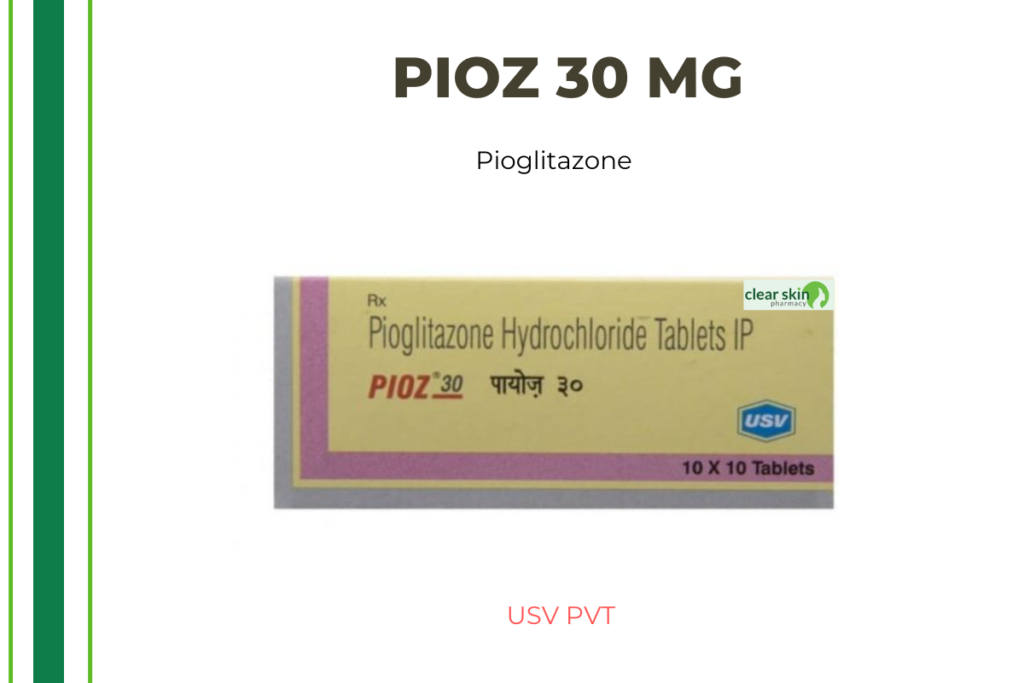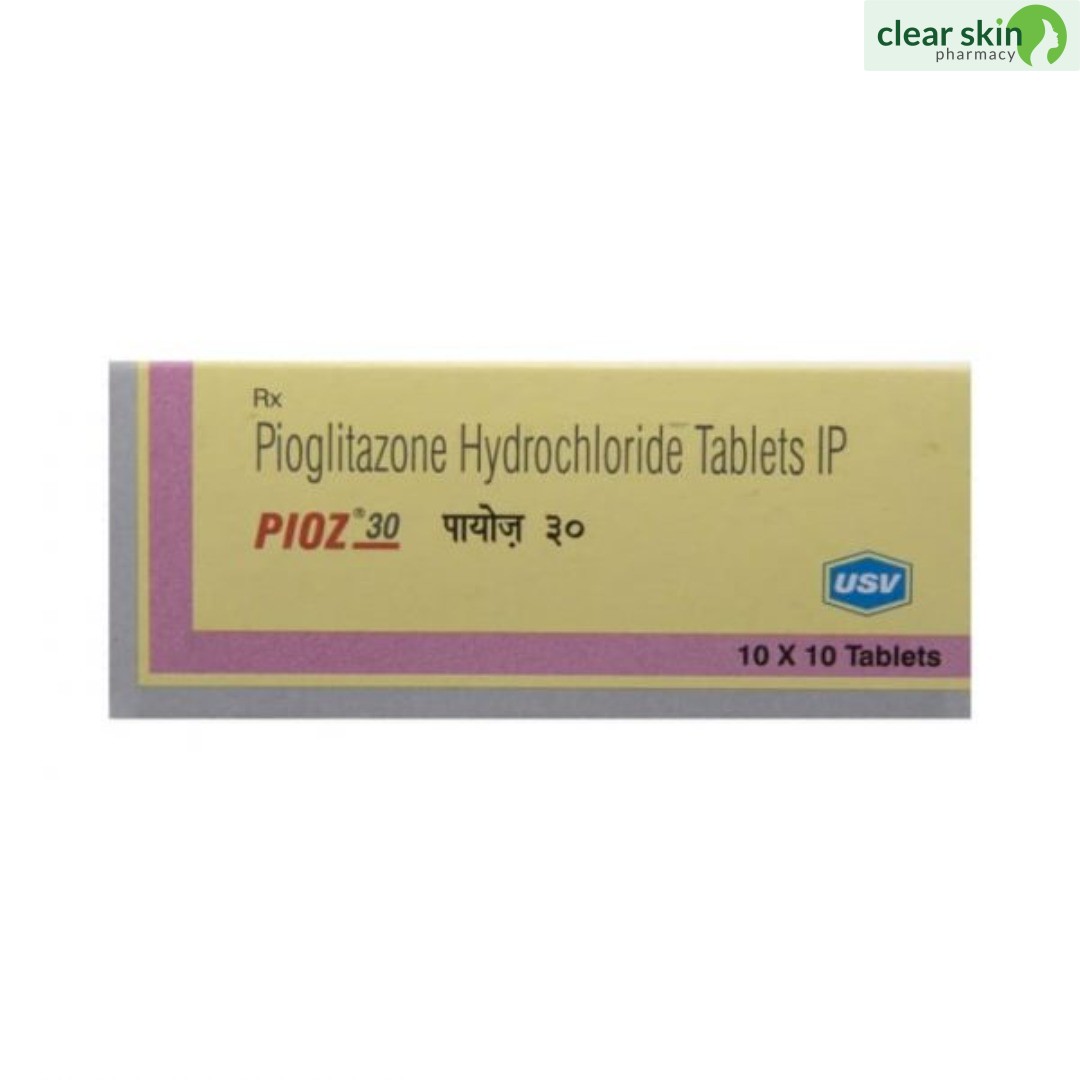Pioz 30
Pioz 30 is an anti-diabetic medicine of the thiazolidinedione (TZD) family, more often known as ‘glitazones.’ It is used to treat diabetes mellitus type 2. (non-insulin-dependent). In type 2 diabetes, the body either does not create enough insulin or the insulin it does make does not act properly. This kind of diabetes develops generally in maturity.
When you have type 2 diabetes, Pioz 30 includes Pioglitazone, a drug that helps your body make better use of the insulin it produces. After 3 to 6 months of Pioglitazone treatment, your doctor will evaluate its efficacy.
Pioz 30 may be used alone or in conjunction with other drugs (including gliclazide, glibenclamide, glipizide, tolbutamide, or insulin) that have failed to successfully control blood sugar. Pioglitazone may also be taken in combination with insulin.
Pioz 30 may be administered with or without meals. For maximum results, the medication should be taken at the same time each day. Your physician will decide the proper dose, which may change frequently depending on your health. Infections of the upper respiratory tract, headaches, sinusitis, myalgia (muscle pain), and pharyngitis are the most often reported adverse effects of Pioz 30.
Even if you feel better, you should not discontinue Pioz 30 without visiting your physician, as your blood sugar level will continue to vary. The risk of vision loss (retinopathy), kidney difficulties (nephropathy), and nerve damage may increase if you abruptly stop taking Pioz 30. (neuropathy). Pioz 30 is contraindicated in patients with type 1 diabetes mellitus, hypersensitivity to Pioz 30 or any of its other ingredients, heart failure or a history of heart failure, diabetic ketoacidosis (a diabetic complication characterized by rapid weight loss, nausea, or vomiting), severe kidney or liver disease, or bladder cancer. Inform your doctor if you have a heart problem, if you are pregnant or want to become pregnant, or if you are nursing. Pioz 30’s safety and efficacy in children under 18 years of age have not been established; hence, it should not be administered to them.
Pioz 30 uses Type 2 diabetes mellitus

Medicinal Advantages
Pioz 30 is an antidiabetic (thiazolidinedione/glitazones) drug used in conjunction with a nutritious diet and regular exercise to assist persons with type 2 diabetes regulate their blood sugar levels (hyperglycaemia). Pioz 30 functions by aiding in the restoration of the body’s natural insulin response, hence reducing blood sugar levels.
Use Instructions
Pioz 30 should not be taken unless prescribed by a physician. Always take Pioz 30 precisely as your doctor has instructed. Based on your medical condition, your doctor will establish the frequency with which you should take your prescriptions. With a full glass of water, the pill should be ingested.
Storage Avoid direct sunlight and store in a cool, dry spot.
Pioz 30 Side Effects
Each drug has its own list of side effects. During the early days of Pioz 30 therapy, you may develop upper respiratory tract infection, headache, sinusitis, myalgia (muscle discomfort), and pharyngitis (inflammation of pharynx located back of neck). However, they would be temporary and may be eased after a while. Consult a physician if you continue to suffer trouble.
Adverse Drug Reactions
Fluid retention (oedema) is possible and may lead to congestive heart failure. Consequently, the use of Pioglitazone in conjunction with insulin and in patients with heart failure may raise the risk of adverse effects. If a blood test reveals that you have renal illness, you should not use pioglitazone. When administered with or without insulin, pioglitazone has a tendency to drastically reduce blood glucose levels. Consequently, the physician may cut the insulin dosage. Some Pioglitazone-using women have observed an increase in fractures. Before commencing Pioglitazone medication, patients with bladder cancer and macular oedema (fluid accumulation in the macula area of the retina) should consult their doctor.
Interactions Between Drugs
Pioglitazone may interact with diabetes drugs (gemfibrozil) and antibiotics (rifampicin). Inform your physician if you are currently taking any of these drugs prior to beginning Pioglitazone.
When coupled with alcoholic drinks, pioglitazone may increase the risk of lactic acidosis (a buildup of lactic acid in the blood) and hypoglycemia.
Pioglitazone should be avoided by those with congestive heart failure (heart-related issues), type I diabetes, bladder cancer, oedema, liver disease, macular oedema, premenopausal anovulation, obesity (weight gain), or anemia, since it may worsen the condition.
Safety Recommendations
ALCOHOL
While using Pioglitazone, avoiding alcohol is advised to prevent unpleasant side effects.
PREGNANCY
Pregnancy is typically contraindicated for pioglitazone. It is uncertain if pioglitazone can damage a developing fetus. If you are pregnant, see your doctor before to using this drug.
BREAST FEEDING
Before using Pioglitazone, it is strongly advised that you consult with a physician.
DRIVING
Pioglitazone will not impair your ability to drive or operate machinery; nevertheless, if you have abnormal eyesight, you should take caution.
LIVER
Pioglitazone should be taken with extreme caution, especially if you have a family history of liver disorders. Your physician may need to adjust the dosage.
KIDNEY
Pioglitazone should be taken with extreme caution, especially if you have a family history of renal illness. Your physician may need to adjust the dosage.
Advice on Diet and Lifestyle
You should fill half your plate with starchy veggies, a quarter with protein, and a quarter with healthy grains.
Consume meals at consistent intervals. Avoid long intervals between meals and snacks.
Monitor your blood sugar often, especially if there are severe fluctuations.
Commit to at least 300 minutes of moderate-intensity and 30 minutes of strenuous physical activity every week.
To maintain a healthy body mass index, weight reduction must be gradual (18.5 to 24.9).
Replace refined carbs with whole grains and increase your consumption of fruits, vegetables, and other fiber-rich meals.
Reduce your consumption of items containing saturated fat (or hidden fat), such as chips, crisps, pastries, cookies, and samosas. Choose omega 3 fatty acid-rich oils for everyday cooking. For frying, utilize palm oil, mustard oil, groundnut oil, rice bran oil, or safflower oil.
Stress might lead to an increase in blood sugar levels. You can employ stress management techniques such as mindfulness, yoga, or meditation to control blood sugar fluctuations-related stress.
Prioritize the acquisition of low-fat dairy products (low-fat yoghurt, fat-free milk and cheese etc.).
Maintain a normal blood pressure as much as possible (120/80). Because it reduces the risk of cardiovascular disease in diabetes individuals.
Special Guidance
Continue to take the medicine even if you feel your glucose levels are steady. If you miss a dose, do not duplicate it; instead, consult a medical professional.
Small, regular meals should be had when taking this medicine to avoid extended fasting. Aware of hypoglycemia symptoms include profuse perspiration, dizziness, palpitations, shivering, intense thirst, dry mouth, dry skin, and frequent urination. If you experience any of the foregoing symptoms, immediately consume 5 to 6 candies, 3 glucose biscuits, or 3 tablespoons of honey/sugar and consult a doctor. Keep them at all times, particularly on lengthy travels.
Before taking this drug, it is usually better if your doctor is aware of any underlying conditions, such as renal or liver disease, a previous heart attack, or alcohol usage.
Avoid consuming alcohol while taking this drug, as it increases the risk of hypoglycemia (a potentially catastrophic dip in blood sugar) and lactic acidosis (when the lactic acid increases in the body which impacts the functioning of various organs in the body).
Stop smoking and restrict your consumption of carbohydrate-rich foods such as potatoes, rice, mangoes, bread, and sugar.
Additional Information : This item is non-refundable.
Glossary of Diseases and Conditions
Type 2 diabetes is a condition in which the body cannot create enough insulin or the insulin it does produce does not work appropriately or is not used properly by the body. This can lead to high blood glucose levels (hyperglycemia). Type 2 diabetes is characterized by an increase in thirst, nighttime urination, poor wound healing, an increase in appetite, fatigue, and impaired vision. In rare situations, weight loss may occur, although weight gain is possible under specific conditions. Neuropathy (nerve damage), nephropathy (kidney damage), retinopathy (damaged retina of the eyes or blindness), amputation of limbs, sexual dysfunction, and an increased risk of heart attack or stroke are consequences of type 2 diabetes.
FAQs
In healthy children and adolescents, type-2 diabetes is uncommon, although it can emerge in obese youngsters, a condition known as Childhood Obesity.
Hypoglycemia is the condition characterized by low blood sugar levels. This is a side effect of the drug Pioglitazone. It is possible to develop hypoglycemia if you skip or postpone meals, consume alcohol, overexercise, or take this prescription with another antidiabetic drug. Consistent monitoring of blood sugar levels is essential.
Consult a doctor if you develop symptoms such as increased appetite, increased thirst, frequent urination (usually at night), unexplained weight loss, weariness, impaired vision, sluggish wound/sore healing, or recurrent infections, since these might indicate type 2 diabetes.
If you sense that your blood sugar is falling and you are getting weak, swallow sweet candies or sugary beverages quickly. It will aid in normalizing the blood sugar levels in your body. Therefore, it is wise to have sugar sweets with you.
Metformin and Pioglitazone are two oral diabetic medicines that manage blood sugar levels in tandem. Metformin and pioglitazone are used in combination with diet and exercise to help manage blood sugar levels in type 2 diabetics who do not require daily insulin injections.
Do not use Pioglitazone if you have or have ever had urinary bladder cancer, diabetic eye disease (retinopathy), or kidney or liver disease. Consult a doctor if the condition is urgent.








Be the first to review “PIOZ 30 MG 10 Tablets”